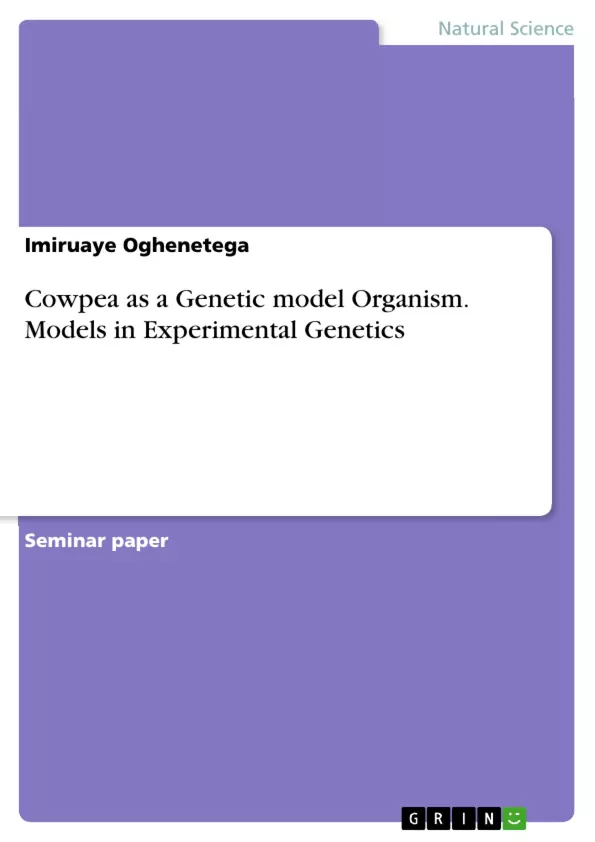Cowpea (Vigna unguiculata) is a tropical grain legume widely distributed in sub-Saharan Africa, Asia, Central and South America as well as parts of southern Europe and the United States (Singh et al., 2002). Domestication of cowpea is presumed to have occurred in Africa given the exclusive presence of wild cowpea (Steele, 1976) although knowledge about the general region or regions of origin and number of domestication events within Africa is fragmented (Ng and Padulosi, 1988; Coulibaly et al., 2002). It is very important, widely adapted, and versatile grain legume of high nutritional value. Cowpea is mainly produced and consumed in Africa, where it provides a major low-cost dietary protein for millions of smallholder farmers and consumers, who cannot afford high protein foods, such as fish and meat. The seed protein content is reported to range from 23-32% of seed weight and therefore is often referred to as a “poor man’s meat” (Diouf and Hilu, 2005). In many parts of West Africa, cowpea hay is also critical as livestock feed, especially during the dry season (Wests and Francis, 1982). Being a legume, cowpea is nitrogen-fixing (Sanginga, 2003) and fits perfectly in the traditional intercropping systems that are common in Africa, especially given its ability to tolerate shade. The total area under cowpea cultivation is more than 12.5 million hectares worldwide, with an annual production of around 4.5 million metric tons (Singh et al., 2002).
Inhaltsverzeichnis (Table of Contents)
- 1.0 Introduction
- 2.0 The Genotoxic Effect of Lead and Zinc on Cowpea
- 2.1 MATERIALS AND METHODS
- 3.0 Assessing the genetic diversity of cowpea [Vigna unguiculata (L.) Walp.] accessions from Sudan using simple sequence repeat (SSR) markers.
- 3.1 MATERIALS AND METHODS
- 3.1.1 Plant materials
Zielsetzung und Themenschwerpunkte (Objectives and Key Themes)
This study investigates the effects of lead and zinc on cowpea chromosomes and assesses the genetic diversity of cowpea accessions from Sudan using SSR markers. The research aims to understand the extent of genetic variation, the likely origin of Sudanese germplasm, and create a mini-core collection based on these findings.
- The genotoxicity of lead and zinc on cowpea
- Genetic diversity of cowpea accessions from Sudan
- Origin of Sudanese cowpea germplasm
- The potential of SSR markers for genetic diversity analysis in cowpea
- The development of a mini-core collection of cowpea germplasm
Zusammenfassung der Kapitel (Chapter Summaries)
The introduction provides background information on cowpea, highlighting its importance as a food legume in sub-Saharan Africa. The second chapter focuses on the investigation of the genotoxicity of lead and zinc on cowpea chromosomes. It outlines the materials and methods used in the experiment, including the preparation of cowpea seeds and the application of different concentrations of lead and zinc nitrate solutions. The third chapter explores the genetic diversity of cowpea accessions from Sudan using SSR markers. It details the materials and methods used in the study, including the collection and cultivation of cowpea accessions from different agro-ecological zones in Sudan and from the International Institute of Tropical Agriculture (IITA) in Nigeria.
Schlüsselwörter (Keywords)
Cowpea, Vigna unguiculata, lead, zinc, genotoxicity, genetic diversity, SSR markers, Sudanese cowpea accessions, mini-core collection, agro-ecological zones.
- Citation du texte
- Imiruaye Oghenetega (Auteur), 2020, Cowpea as a Genetic model Organism. Models in Experimental Genetics, Munich, GRIN Verlag, https://www.grin.com/document/914607



